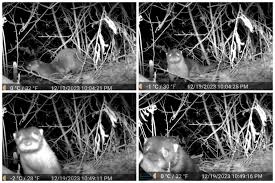In a remarkable turn of events, an American river otter has made a comeback in the Ridley Creek watershed after more than a century of absence. Situated as a tributary of the Delaware River, nestled within Chester and Delaware counties near Philadelphia, Ridley Creek is now witnessing the return of these elusive creatures, particularly in the southeastern region of Chester County.
The Willistown Conservation Trust, a nonprofit organization dedicated to preserving natural habitats within the watersheds of Ridley, Crum, and Darby creeks, has captured the otter’s presence through images captured on a game camera installed in the area. This milestone event highlights the success of regional conservation efforts and emphasizes the critical need to safeguard natural habitats for wildlife.
Once abundant throughout North American waterways before the arrival of European settlers, American river otters faced a decline in the early 1900s due to fur trapping and habitat destruction. However, concerted reintroduction efforts in the 1980s, particularly in northern Pennsylvania, led to a resurgence in their population.
The resurgence of the American river otter in the Ridley Creek watershed is not only a significant ecological event but also a testament to the positive impact of conservation initiatives in the region. These creatures are highly sensitive to pollution and habitat degradation, making their return a strong indicator of improving water conditions and ecosystem health.
The Willistown Conservation Trust has been at the forefront of habitat restoration and open space protection within the Ridley Creek Watershed since its establishment in 1996. Recent land acquisitions, including the purchase of Kirkwood Farm by movie director M. Night Shyamalan, have further bolstered conservation efforts. The trust plans to open the preserved land, now known as Kestrel Hill Preserve, to the public.
The sighting of the American river otter near Okehocking Run, a tributary to Ridley Creek, underscores their crucial role as a keystone species in aquatic ecosystems. As predators, they help regulate prey populations and modify habitat structures, contributing to the overall balance of the ecosystem.
Tom Keller, the Pennsylvania Game Commission’s furbearer biologist, attributes the otter’s return to the collective dedication and passion of the community towards watershed conservation. This inspiring example highlights the positive outcomes that can be achieved through collaborative conservation efforts and serves as a beacon of hope for the future of wildlife preservation.















































